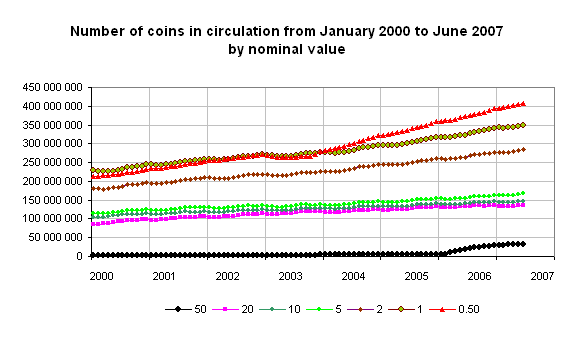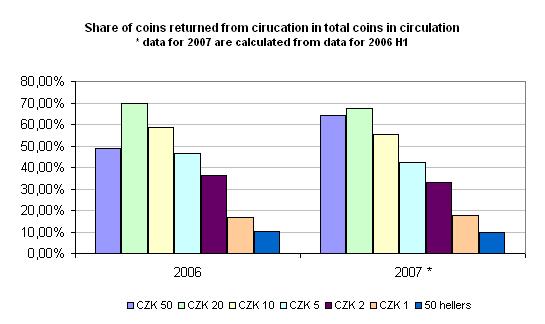The CNB decides 50-heller coins will cease to be legal tender
The Bank Board of the Czech National Bank has decided that 50-heller coins will cease to be legal tender on 31 August 2008. It will not be possible to pay with these coins for goods and services from 1 September 2008 onwards.
"The main reason for this decision is that 50-heller coins are ceasing to fulfil their function as circulating currency. A total of 410 million such coins are currently in circulation, representing 41 per person including babies," said Pavel Řežábek, Chief Executive Director and Member of the CNB Bank Board.
The period for which commercial banks will exchange invalid coins will be set at one year in a CNB decree. This period, which is of the same length as in previous withdrawals of banknotes and coins, will begin on 1 September 2008 and end on 31 August 2009. In accordance with the decree, the Czech National Bank will accept and exchange invalid 50-heller coins for another five years, i.e. until the end of August 2014.
As in the case of 10-heller and 20-heller coins, which ceased to be legal tender in 2003, 50-heller coins have gradually ceased to fulfil their functions, especially the function of circulating currency. In practice, this means that only 10% of these coins return from circulation to the central bank. This reflects changes in the behaviour of most money circulation participants and in consumer preferences, a decline in the importance of this coin in money circulation and its low popularity with the public.
The cost of producing 50-heller coins is not very high, running to just a few million korunas a year. However, one also needs to take into account the difficult-to-quantify costs incurred by all money circulation participants for processing, distributing and handling these coins. While the other coins have steel cores coated in nickel, copper or brass and are easy to handle, 50-heller coins are made of aluminium, which wears away easily and contaminates coin-counting machines. Moreover, standard coin-processing lines cannot be used for 50-heller coins, which must be processed manually.
In connection with the withdrawal of 10-heller and 20-heller coins, the Czech Parliament approved an amendment to the Consumer Protection Act which clearly defines how vendors may proceed in rounding: "... when setting the final price to be paid in cash for goods sold and services provided, the sum shall be rounded to the nearest valid denomination of the legal tender in circulation."
"As previously, it will still be possible to state prices of goods and services in hellers and multiples thereof. The current practice will remain unchanged and only the final sums for cash payments will be rounded to whole korunas. Thus, the impact on inflation will be hardly visible, as was the case when the 10-heller and 20-heller coins ceased to be legal tender," added Pavel Řežábek, Chief Executive Director and Member of the CNB Bank Board. "We also believe that the public will welcome that fact that the contents of their wallets will become easier to deal with when these infrequently used coins disappear."

